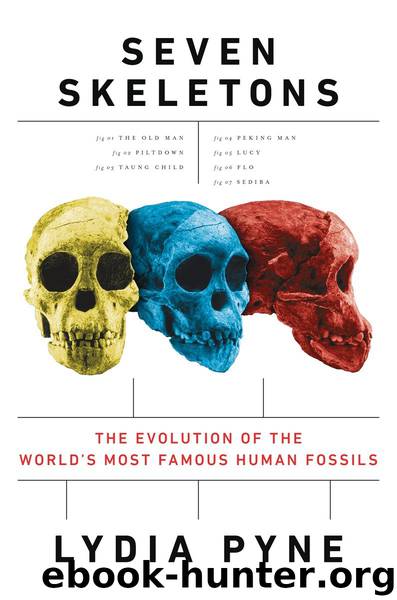Seven Skeletons by Lydia Pyne

Author:Lydia Pyne
Language: eng
Format: epub
Publisher: Penguin Publishing Group
Published: 2016-07-27T10:29:22+00:00
Painted casts of Peking Man skull at the Cenozoic Research Laboratory on a laboratory bench. From Paramount News film, early 1930s. (Film courtesy of the American Museum of Natural History Library and Dr. Milford Wolpoff)
—
“In 1539 the Knight Templars of Malta paid tribute to Charles V of Spain, by sending him a Golden Falcon encrusted from beak to claw with the rarest jewels—but pirates seized the galley carrying this priceless token and the fate of the Maltese Falcon remains a mystery to this day,” reads the introductory text that appears after the opening credits in the 1941 film The Maltese Falcon. It is the story of a treasure hunt for a priceless object and the motivations that fuel that hunt. The “black bird” that Kasper Gutman and Sam Spade search for is that jewel-encrusted falcon, which, by the 1940s, was said to have been covered in a deep black patina to hide the bird’s true value. In the film’s dramatic reveal—where the bird is proven to be a fake—the audience is told that the bird is more myth than fact. In the end, actually finding the bird wasn’t as important as cultivating the belief in what it stood for. The bird, Sam Spade dryly notes, is the “stuff that dreams are made out of.”
Today, the only pieces of the Peking Man in Chinese collections are five teeth and some parts of a skull found in the renewed excavation of the 1950s and 1960s. The Uppsala Museum of Evolution has three teeth from the original excavations in the 1920s; these are considered the “collection’s highlights.” When the tooth was discovered in the boxes of Professor Carl Wiman’s stuff, that tooth, newly reexcavated from the archives, became a significant part of the Peking Man’s story. Like that tooth, Peking Man’s story is one of abrupt beginnings and endings, encounters and losses; it’s a story of details and dramatic events—kind of like The Maltese Falcon, but with fossils.
“As is well known, almost all material from this excavation period (except the original Uppsala teeth) was lost in 1941, and has never been recovered,” Swedish research Dr. Per Ahlberg said in an interview. “After the war, Chinese scientists continued to excavate Zhoukoudian and found some new fossils in the deeper layers. But this new tooth is most probably the last fossil from the ‘classical’ Peking Man excavations that will ever be found.” Ahlberg continued, “We can see many details that tell us about the life of the owner of the tooth, which is relatively small, indicating that it belonged to a woman. The tooth is also rather worn, so the person must have been rather old when she died. Also, parts of the tooth enamel have been broken off, probably indicating that the person had bitten down on something really hard, like a bone or a nut. We should probably now be talking about a ‘Peking Woman’ and not a ‘Peking Man.’” Professor Liu Wu, from the Chinese Academy of Sciences, chimed in with his
Download
This site does not store any files on its server. We only index and link to content provided by other sites. Please contact the content providers to delete copyright contents if any and email us, we'll remove relevant links or contents immediately.
Sapiens: A Brief History of Humankind by Yuval Noah Harari(13052)
The Tidewater Tales by John Barth(12030)
Do No Harm Stories of Life, Death and Brain Surgery by Henry Marsh(6336)
Mastermind: How to Think Like Sherlock Holmes by Maria Konnikova(6235)
The Thirst by Nesbo Jo(5785)
Why We Sleep: Unlocking the Power of Sleep and Dreams by Matthew Walker(5641)
Sapiens by Yuval Noah Harari(4537)
Life 3.0: Being Human in the Age of Artificial Intelligence by Tegmark Max(4507)
The Longevity Diet by Valter Longo(4445)
The Rules Do Not Apply by Ariel Levy(3905)
The Immortal Life of Henrietta Lacks by Rebecca Skloot(3826)
The Body: A Guide for Occupants by Bill Bryson(3801)
Why We Sleep by Matthew Walker(3771)
Animal Frequency by Melissa Alvarez(3755)
Yoga Anatomy by Kaminoff Leslie(3701)
Barron's AP Biology by Goldberg M.S. Deborah T(3631)
The Hacking of the American Mind by Robert H. Lustig(3580)
All Creatures Great and Small by James Herriot(3516)
Yoga Anatomy by Leslie Kaminoff & Amy Matthews(3395)
